Oiwai!(Celebrations)
The debut of new Maiko and Geiko ,’Omisedashi’&’Erikae’

Maiko,Satsuki san of Gion-Kobu
It was the autumn dance festival rush in hanamachi (flower towns) this month. Starting with Onshu-kai of Gion-Kobu, there was Kotobuki-kai of Kamishichiken, Mizue-kai of Miyagawa-cho and Suimei-kai of Ponto-cho successively.
Yes,October is one of the busiest time for both maiko and geiko in the year. In spite of that, there were several chances to get to see their graceful appearance at some events held at every corner of Kyoto.
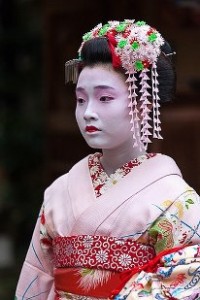
Maiko,Mameroku san of Gion-Kobu
At the Nijyo Castle Festival, maiko from Gion-Kobu lined up. On the first day, it has become a custom that they welcome customers with gifts at the opening event. For this year, there were four of them-Satsuki san, Masaki san, Katsutomo san and Mameroku san.
A splendid array of geiko and maiko from Kamishichiken was seen at the Zuiki Festival of Kitano Tenmangu (Shrine).They all stand along the road of teahouses to see off the portable shrine paraded the town.
Still, it must be remembered that there is one of the three major festivals in Kyoto,the Jidai Matsuri(the Jidai Festival). They wear great-flamboyant costumes which reproduce the historical female icons like Seishonagon, Murasakishikibu, Ononokomachi and Tokiwagozen.The procession that geiko and maiko participate is called as “Heianjidai fujinretsu.”
Above all, the attention of the public is commanded to who perform ‘Tomoegozen’,the legendary female samurai lived in the Heian period. It was geiko, Hisakayo san of Ponto-cho for this year. You can’t help giving a sigh to see how distinguished and noble she looks. It was bold and bewitching at the same time, a mysterious charm was formed.
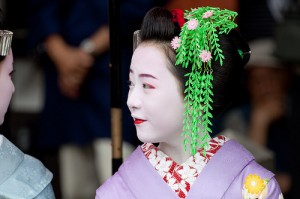
Maiko,Masaki san of Gion-Kobu
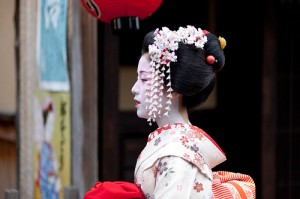
Maiko,Katsutomo san of Gion-Kobu
As having told you, Kyoto in autumn is full of dance festivals and events. It is in pride of a lively and vibrant season, and furthermore, there was some joyful events in hanamachi!
A new maiko, Umechie san has debuted on 2nd of October. To debut as a professional maiko is called“Omisedashi” and for the flower town of Kamishichiken, it was the debut in two years. (Umechie san also appears on the issue, Monthly Geisha in September,2012)
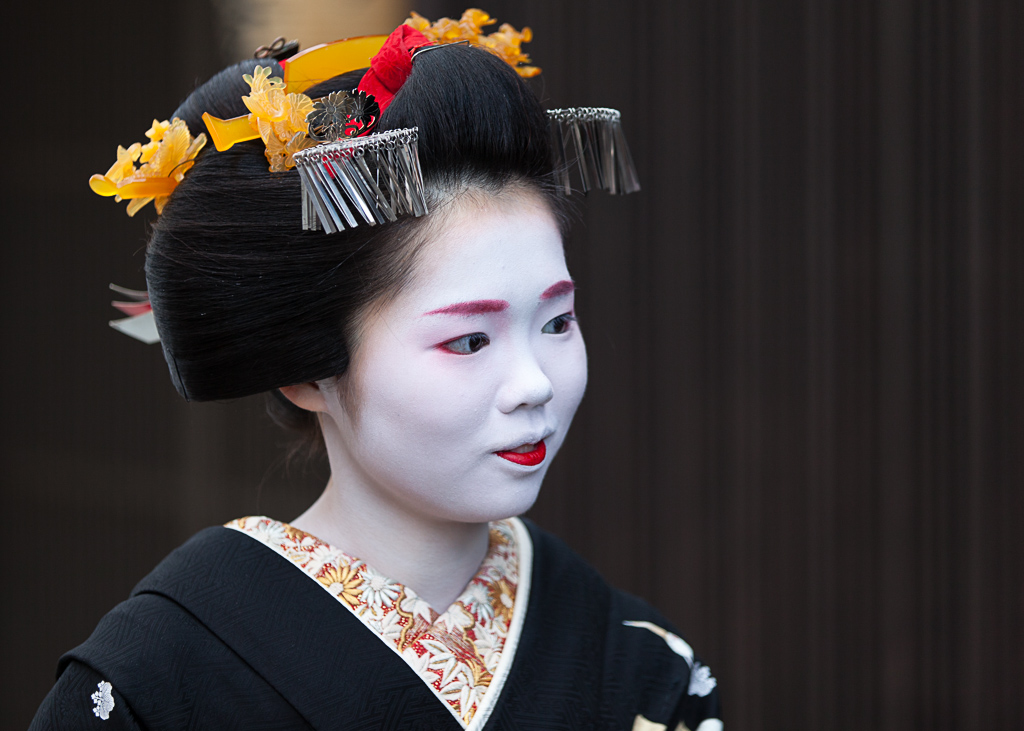
Just like a silver-colored kanzashi swinging on her hair, a face looks so cool. This was taken during TV interview on Omisedashi day
It was 5th of January this year, when Umechie san first entered yakata(or okiya, a boarding house for maiko) as ‘shikomi san’ (girls preparing to become a professional maiko).It is Umeno in Kamishichiken where combine housing with ochaya (a place where ozashi is held).
In the year before, she came to hanamachi for an interview with her father, she was still sixteen years old at that time and lived with family in Yokohama which distance is approximately 500km away from Kyoto.
“When I first saw her in face, I thought she looked clever,”okami says. There are so many maiko applicants, and today most of them are not from Kyoto, they are from provinces-from the Tohoku region in north to the Okinawa region in very south of Japan. They come to hanamachi in a stream for the interviews like Umechie san did.
But things are not that easy here. “Well, she’s not cut out for maiko,”once okami considers them to be not worth bringing up as maiko, then the will be refused and never be able to cross the threshold again.
Fortunately, Umechie san passed the first examination without a hitch. However the way of maiko training is full of trials and tribulations. The more I hear about how she trains, the more I marvel how she manages to complete.
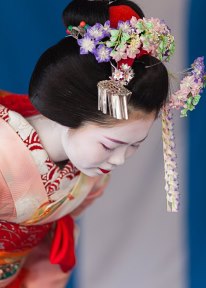
Umechie san when she was still‘minarai san.’Minarai period is a time to get used to various styles and things in ozashiki with onesan (senior maiko, literally means older sister)
“For Umechie san, to live together with me and other elder maiko in the same place, it naturally means to stay together all the time except hours of sleep, doesn’t it?I always tell her, try to learn everything by watching with your eyes and listening by your ears. This is about everything, you know. It is not like a school here, so there is nothing like a class. It is the only way for her to learn all sorts of things to become a professional maiko by living everyday life with us,”and okami continues.
“Though, there’s something to start with. I tell her to do seiza in a proper way. It is a kind in ways of sitting, you kneel with the tops of the feet on the floor. As far as she is here to become maiko, she must seiza when she talks with us, and of course at ozashiki, she cannot throw out her legs in front of customers, you know? Umechie san was quite all right with learning how to sit, but she had a great difficulty with ‘the language’,because she’s originally from the Kanto region.”
All people in hanamachi use a special language called ‘Hanamachi-Kotoba.’It is different from both standard Japanese spoken and a regional dialect in Kyoto, Former one is widely used in the Kanto area including Tokyo and Kanagawa where Umechie san comes from.
‘Hanamachi-Kotoba’has lively ,elegant but restrained accent. If you hear a sound of it, you might feel like listening to some relaxing music and want to be intoxicated to your heart’s content. But when it comes to learning it, this is another story. I can say it is like a complete foreign language.In fact,“When I first came here, I thought I’ve arrived in an exotic country by mistake,”Umechie san says.
There is no such thing as a textbook, the only way for her is to learn one by one in everyday life. “If I find a mistake in the use of language, I correct her straight away, no matter how small it is,”Okami declares and continues.
“After all, it is good for her to be strict. It is no good for her to spoil. I don’t want her to be embarrassed when she becomes a professional. Use of words, a way of thinking…basically about everything, I want her to learn in a proper, polite way. It is not just about her as maiko, but as well as a woman. Anyway, she is trying very hard now.” You can imagine she must have made an enormous effort.
Umechie san started learning mai(dancing) almost at the same time to live in the yakata(okiya). At ozashiki (the party or banquet held with geiko and maiko), she worked as a helper, serving foods and drinks to customers.
As okami said, she had learned every style of hanamachi by constantly practicing it in a real life. Between the hard training, she has spent 9 months doing daily house works like cleaning, washing and running errands simultaneously.
And finally the debut day has arrived, but…I just couldn’t help asking this question.“Have you ever thought of giving up, while the training?”She gave me an immediate answer in a clear voice,“No, I’ve never thought like that.”
There was a gentle expression on her face, but I was startled with her words that made me feel her mental strength. At the beginning, her parents objected to her decision to become a professional maiko, but it was her dream to be the one since childhood and it really ignited her.
She says there was a strong feeling to work on herself. “I was fed up with myself being irresponsible and incomplete. I knew it is extremely strict in maiko’s world, but I decided to quit High School and made a plunge into this hanamachi.”

Umechie san walking in a town of Kamishichiken. On Omisedashi day, she pays courtesy calls to teahouses, eating-houses, etc.
And ‘Omisedashi‘ day has come. It is a significant event for yakata as well as for the one to debut. Umechie san wore ‘kuromontsuki’, the finest formal kimono in black, with ‘darari-no-obi’ in shining golden-color. And for her feet, okobo is worn.
It is the shoes made of paulownia wood by skilled artisans in Japan. In hanamachi, I often see maiko walking at a smart pace on this 5 inches (approximately) high-heel, it was lighter than I thought when I held a pair, but it is completely another thing comparing to usual heels we wear in daily life.
There must be a hard training days to get used to walk in these, just like models practice how to walk on the catwalk. Talking about the thong’s colors, red is the first one to wear as a professional. Then here comes pink, wisteria violet, green bamboo…after the first one there are some color variations and it differs with each yakata.
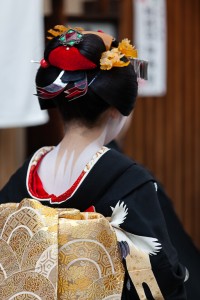
Sanbonashi (three legs) is worn on a formal occasion like’omisedashi.’How elegant is that!?
Her hair is tied in wareshinobu style decorated with silver birakan (type of kanzashi), tamakan (type of kanzashi) decorated with coral. And more, there are the rare bekko kanzashi (the ones made in tortoiseshell) arranged with red-colored kanoko (tie-dyed cloth with a pattern of minute rings). She just looked dazzlingly gorgeous.
To tell the truth, it is the yakata who prepares all these ornaments.It is said that even one pocchiri (sash clip) costs hundreds of thousands of yen each.
Some costs over millions of yen, so you can imagine the total amount of outfits will be incredibly unimaginable price. I hear it all differs between each hanamachi, but at the same time, it is said that you can build a house with the money to train and raise up a successful maiko!
And as well for the person in question, it is a matter of course to grow feelings of preparing her mind by wearing the expensive clothing and accessories this much.
All money which costs for her debut will be returned from her to okiya, once she has become a professional maiko. This includes expenses for ornaments, barber, mai(dancing)practice and living costs spent since the first day she has started to live in okiya as ‘shikomi san.’
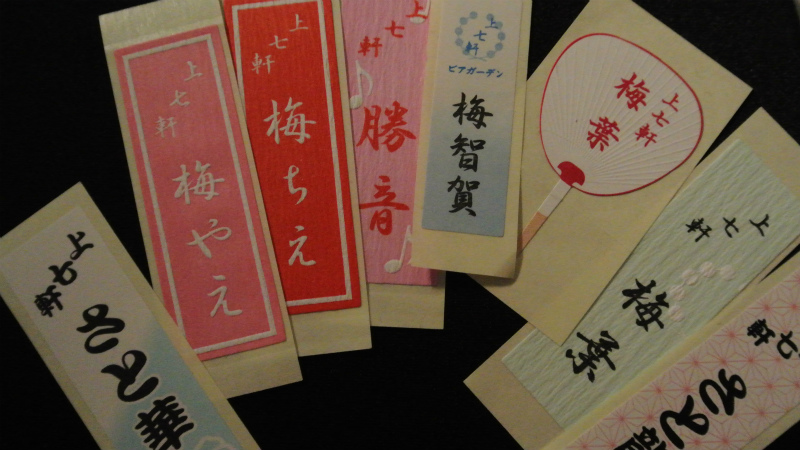
These little stickers are maiko’s hanameishi(like a business card).The red one with white letters is Umechie san’s
It seems Umechie san has a little bit of ‘bitter’memory at ozashiki just before the official debut.“When it is a period of shikomi training, we wear usual kimono or yukata(light kimono made in cotton),so the hem comes just right on her ankle.”
“But when you become ‘minarai san’(maiko apprenticeship),you wear the same kimono as maiko. It is called ohikizuri, the kimono with a trailing hem. I was not so used to wearing it, and on one day when I performed a mai(dancing) to ‘Gion Kouta’(the most famous and loved Japanese ballad accompanied on the shamisen in hanamachi), my feet was caught with hem and I was about to tumble down. Shame on me…,”she gave a shrug, apologetically.
But okami added like this.“Every single maiko is the same.They all stumble over the long hem for the first time.” During the minarai period, she went around several ozashiki with elder maiko. Among customers, it was already said that they are pretty sure for her popularity in near future. In Kamishichiken, she is the 8th maiko. It is a pleasure for us to expect her to do great things!
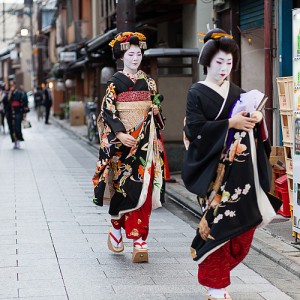
Fukucho san walking around the town of Miyagawa-cho to pay courtesy calls with Onesan
(senior geiko, literally means older sister)
Well, there was another ‘omisedashi’held in Miyagawa-cho. On the 27th, it was Fukucho san who debuted and on the 29th, and there was Kyoka san ’s‘erikae in Gion-Kobu.
‘Erikae’ is to become geiko (mature geisha) from maiko (geisha). On the day, she went around the flower town to pay courtesy calls one by one just like ‘omisedashi’.
When they become geiko, it is a vital necessity to polish up the skills in performing arts. Their difference with maiko is not only how they dress and hairstyles. For them, beauty and youth is not the only elements demanded.
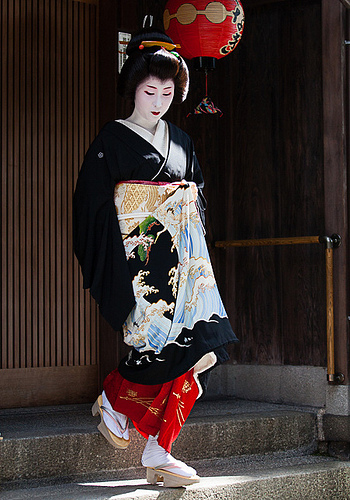
Kyoka san of Gion-Kobu, She has become even more captivating than before
Things like a sophisticated conversation, richness in subjects and even the state of mind…it is a profession when one can embody the total beauty.
It seems like a severe world, but if you change a view point, there is no other greater occupation like this for women. Because she can both raise a level of herself and work every single day.
This makes sense to us that the number of young girls who dream of becoming maiko remains great, doesn’t it!? Let us propose a toast to their new start and wish them every bit of luck for the future. Congratulations to Umechie san, Fukucho san and Kyoka san!
Maiko’s Kanzashi in October

The language of flowers for chrysanthemum is “nobility.”It really suits maiko in autumn
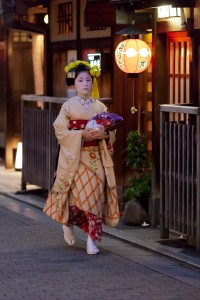
If cherry blossom is for spring, autumn’s symbol is the chrysanthemum. Maiko’s kanzashi in October is mainly on this flower motif. It is one of the flowers beloved for a long time in Japan.
It was used as a design on a face of 50 yen coin, and in the Kamakura period, it was in fashion as ‘Makie’(lacquer decoration sprinkled with metal powder) and patterns of clothing.
This is Katsutomo san of Gion-Kobu.It is so touchingly lovely, the small yellow flowers looking like Spray mum. The look gives you a feeling of expectation for young maiko’s bright future.

And this is Fukusato san of Miyagawa-cho. When you become elder maiko, you wear the ones somewhat large. Please give a close look at the largest flower decorated around the temple.
Its size is about half of her face! It is simple, but amazingly bold in design.
Highlight events in Kyoto,October
|
● The 20th -25th of November |
|
●The 20th -25th of November 9:00-16:45 at Ninomarugodendaisho |
|
●The 20th -11th of November 8:45-17:00 |
|
●The 11th of November |
|
●The 28th ,1st and 3rd of November 9:30-15:00 |
|
●The 3rd and 11th of November 10:00&13:30 |
Photos:Copyright(c)2012 Geisha Japan All Rights Reserved
Special Thanks to: WALKKYOTO(some images on this article are provided by http://walkkyoto.exblog.jp/i30/ )




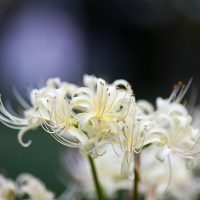
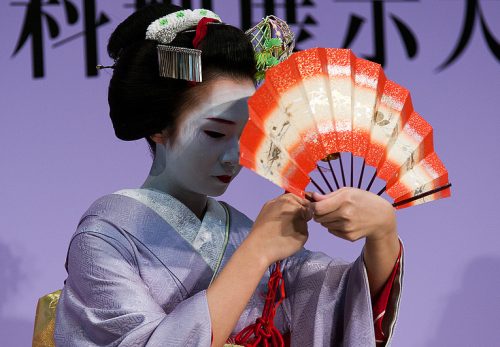
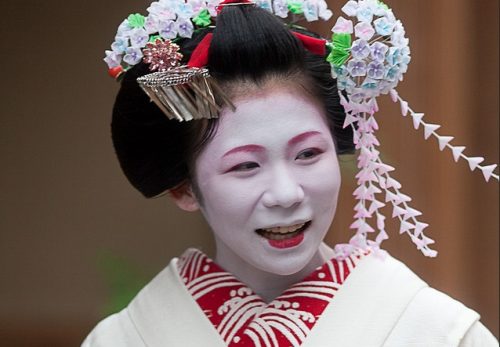
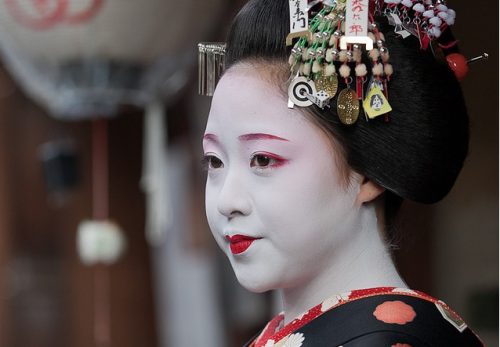
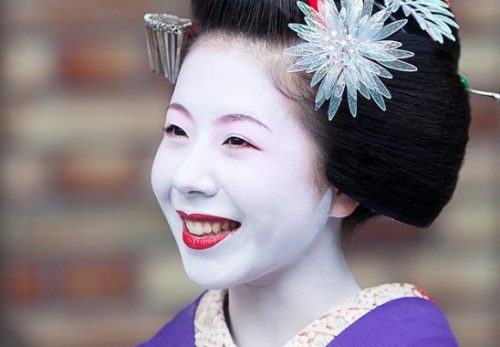
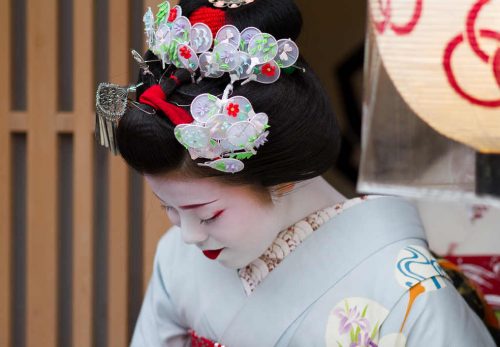
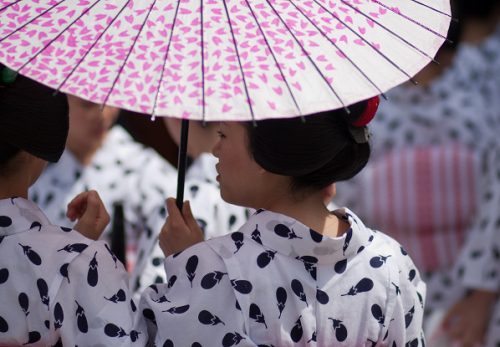
この記事へのコメントはありません。